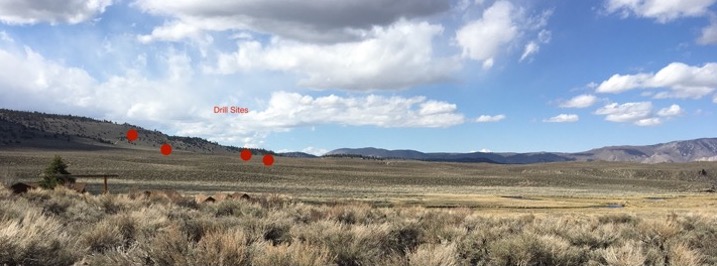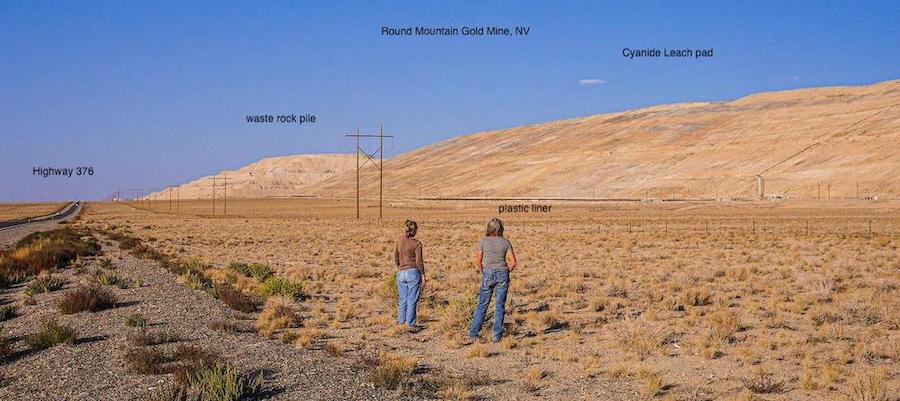
Photo credit: Lynn Boulton Kore Mining's drill sites from Hot Creek Road at Hot Creek Ranch.
The US Forest Service approved the Long Valley Exploratory Drilling Project on September 27. In response, the Sierra Club along with three other conservation organizations, CBD, FOI, and Western Watersheds Project, filed a National Environmental Protection Act (NEPA) complaint against the US Forest Service for approving the Long Valley Exploratory Drilling Project as a Categorical Exclusion. Under a “Cat Ex” the Forest Service reviews Kore Mining’s Plan of Operations and supporting reports and gives them the go ahead. A “Cat Ex” bypasses the environmental review step that allows the public to comment on it as well. The Range of Light Group and the coalition have major concerns about the impact to the declining Bi-state Sage Grouse in the area and the lack of data about the impacts of drilling into the geothermal aquifer in a highly fractured area. What is known is that the sage grouse use the area in and around the project site and that the groundwater in the project area is connected to Hot Creek and Little Hot Creek that bookend the project site. With this project Kore Mining will be drilling up to 3 holes at 12 sites to depths of 580 to 1,424 feet—well into the groundwater zone where they expect to encounter water temperatures ranging from 71 to 183 oF. The depth-to-water could vary from 69 to 425 feet. Drilling will be 24/7 once drilling starts a hole requiring flood lights at night.
The 1872 General Mining Act allows claim holders access to their minerals no matter what the impacts of doing so are. The USFS cannot deny this project. However, they can impose mitigations and restrictions. More mitigations could have been applied to shield the Bi-state Sage Grouse from impacts; even stronger mitigations if they were an endangered or threatened species. The Forest Service, alone, has spent millions of dollars in protecting the sage grouse and improving its habitat as part of a collaborative effort to save the species. The USFS, BLM, USGS, ranchers, conservation NGOs and others formed the collaborative and created an action plan in 2012 expressly to avoid a listing; hoping for better cooperation, teamwork, and broader support that might prove to be more effective. Now the Inyo Forest Service undermines those efforts with this project.

Photo credit: Lynn Boulton Sage Grouse crossing Antelope Springs Rd.
Kore is already saying a gold mine here could be profitable at current gold prices with what is known from when Royal Gold drilled in the same location 23 years ago. https://www.koremining.com/long-valley This drilling project will only sweeten the pot for a future gold mine if the results from this drilling project are positive. Royal Gold explored the oxidized layer—the first 250 feet below the surface--and determined that 0.018 ounces of gold can be extracted per ton of earth. Kore Mining will be exploring the sulfide layer below it hoping the gold will be more concentrated or that they find a gold vein. Data from this project would only mean the open-pit mine would be deeper and wider and the cyanide heap leach pads would be bigger mountains of dirt.
Heap leach pads and waste rock piles are big. Take a drive from Tonapah, NV to Eureka, NV along State Highway 376. Half-way there, you will pass the Round Mountain Gold Mine with its enormous leach pads and waste rock piles. The reality is sobering. Gold mining today is destructive and erases mountains just as mountain-top coal mining and copper strip mining do. The Ruby Mountain Mine outside of Eureka is a smaller operation and is more like what a gold mine at Hot Creek would be like. Still, the Eastern Sierra would be marred forever by a gold mine.

Photo credit: Bob Tyson Leach pad at Round Mountain gold mining operation with a waste rock pile in the distance.